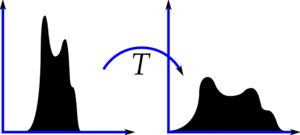文章目录
前言
CSDN博客好久没有换过头像了,想换个新头像,在相册里面翻来翻去,然后就找到以前养的小宠物的一些照片,有一张特别有意思
惊恐到站起来的金丝熊:这家伙不会要吃我吧
没见过仓鼠的小猫:这啥玩意儿?
好,就决定把这张图当自己的头像了
一顿操作之后,把头像换成了这张照片

此时我:啥玩意儿?
。。。。感觉黑乎乎的,啥也看不清
这时候我想起来我学过图像处理,这用亮度变换搞一下不就可以了吗,搞起来!
注意:一般对灰度图进行亮度变换的多一点,但是我这张图是RGB图(准确来说是RGBA,但我们只取前三个通道),对于RGB图,我这里对其每个通道分别进行处理然后拼接处理
处理
对比度拉伸
也就是把图像重新缩放到指定的范围内
# 对比度拉伸
p1, p2 = np.percentile(img,(0,70))# numpy计算多维数组的任意百分比分位数
rescale_img = np.uint8((np.clip(img, p1, p2)- p1)/(p2 - p1)*255)
其中,numpy的percentile函数可以计算多维数组的任意百分比分位数,因为我的图片中整体偏暗,我就把原图灰度值的0% ~ 70%缩放到0 ~255
log变换
使用以下公式进行映射:
O
=
g
a
i
n
∗
l
o
g
(
1
+
I
)
O = gain*log(1 + I)
O=gain∗log(1+I)
# 对数变换
log_img = np.zeros_like(img)
scale, gain =255,1.5for i inrange(3):
log_img[:,:, i]= np.log(img[:,:, i]/ scale +1)* scale * gain
Gamma校正
使用以下公式进行映射:
O
=
I
γ
∗
g
a
i
n
O = I^{\gamma} * gain
O=Iγ∗gain
# gamma变换
gamma, gain, scale =0.7,1,255
gamma_img = np.zeros_like(img)for i inrange(3):
gamma_img[:,:, i]=((img[:,:, i]/ scale)** gamma)* scale * gain
直方图均衡化
使用直方图均衡后的图像具有大致线性的累积分布函数,其优点是不需要参数。
其原理为,考虑这样一个图像,它的像素值被限制在某个特定的值范围内,即灰度范围不均匀。所以我们需要将其直方图缩放遍布整个灰度范围(如下图所示,来自维基百科),这就是直方图均衡化所做的(简单来说)。这通常会提高图像的对比度。
这里使用OpenCV来演示。
# 直方图均衡化
equa_img = np.zeros_like(img)for i inrange(3):
equa_img[:,:, i]= cv.equalizeHist(img[:,:, i])
对比度自适应直方图均衡化(CLAHE)
这是一种自适应直方图均衡化方法
OpenCV提供了该方法。
# 对比度自适应直方图均衡化
clahe_img = np.zeros_like(img)
clahe = cv.createCLAHE(clipLimit=2.0, tileGridSize=(8,8))for i inrange(3):
clahe_img[:,:, i]= clahe.apply(img[:,:, i])
处理结果展示
使用Matplotlib显示上述几种方法的结果:
可以看到,前四种方法效果都差不多,都有一个问题亮的地方过于亮,这是因为他们考虑的是全局对比度,而且因为我们使用的彩色图像原因,使用log变换的结果图中有部分区域色彩失真。最后一种CLAHE方法考虑的是局部对比度,所以效果会好一点。
因为图像是彩色的,这里我只绘制了R通道的直方图(红色线)及其累积分布函数(黑色线)
可以看到均衡后的图像具有大致线性的累积分布函数。
总之,经过以上的探索,我最终决定使用CLAHE均衡后的结果

感觉是比之前的好了点
附源码
opencv版本
import cv2.cv2 as cv
import matplotlib.pyplot as plt
import numpy as np
defplot_img_and_hist(image, axes, bins=256):"""Plot an image along with its histogram and cumulative histogram.
"""
ax_img, ax_hist = axes
ax_cdf = ax_hist.twinx()# Display image
ax_img.imshow(image, cmap=plt.cm.gray)
ax_img.set_axis_off()# Display histogram
colors =['red','green','blue']for i inrange(1):
ax_hist.hist(image[:,:, i].ravel(), bins=bins, histtype='step', color=colors[i])
ax_hist.ticklabel_format(axis='y', style='scientific', scilimits=(0,0))
ax_hist.set_xlabel('Pixel intensity')
ax_hist.set_xlim(0,255)# 这里范围为0~255 如果使用img_as_float,则这里为0~1
ax_hist.set_yticks([])# Display cumulative distributionfor i inrange(1):
hist, bins = np.histogram(image[:,:, i].flatten(),256,[0,256])
cdf = hist.cumsum()
cdf = cdf *float(hist.max())/ cdf.max()
ax_cdf.plot(bins[1:], cdf,'k')
ax_cdf.set_yticks([])return ax_img, ax_hist, ax_cdf
defplot_all(images, titles, cols):"""
输入titles、images、以及每一行多少列,自动计算行数、并绘制图像和其直方图
:param images:
:param titles:
:param cols: 每一行多少列
:return:
"""
fig = plt.figure(figsize=(12,8))
img_num =len(images)# 图片的个数
rows =int(np.ceil(img_num / cols)*2)# 上图下直方图 所以一共显示img_num*2个子图
axes = np.zeros((rows, cols), dtype=object)
axes = axes.ravel()
axes[0]= fig.add_subplot(rows, cols,1)# 先定义第一个img 单独拿出来定义它是为了下面的sharex# 开始创建所有的子窗口for i inrange(1, img_num):#
axes[i + i // cols * cols]= fig.add_subplot(rows, cols, i + i // cols * cols +1, sharex=axes[0],
sharey=axes[0])for i inrange(0, img_num):
axes[i + i // cols * cols + cols]= fig.add_subplot(rows, cols, i + i // cols * cols + cols +1)for i inrange(0, img_num):# 这里从1开始,因为第一个在上面已经绘制过了
ax_img, ax_hist, ax_cdf = plot_img_and_hist(images[i],(axes[i + i // cols * cols], axes[i + i // cols * cols + cols]))
ax_img.set_title(titles[i])
y_min, y_max = ax_hist.get_ylim()
ax_hist.set_ylabel('Number of pixels')
ax_hist.set_yticks(np.linspace(0, y_max,5))
ax_cdf.set_ylabel('Fraction of total intensity')
ax_cdf.set_yticks(np.linspace(0,1,5))# prevent overlap of y-axis labels
fig.tight_layout()
plt.show()
plt.close(fig)if __name__ =='__main__':
img = cv.imread('catandmouse.png', cv.IMREAD_UNCHANGED)[:,:,:3]
img = cv.cvtColor(img, cv.COLOR_BGR2RGB)
gray = cv.cvtColor(img, cv.COLOR_BGR2GRAY)# 对比度拉伸
p1, p2 = np.percentile(img,(0,70))# numpy计算多维数组的任意百分比分位数
rescale_img = np.uint8((np.clip(img, p1, p2)- p1)/(p2 - p1)*255)# 对数变换
log_img = np.zeros_like(img)
scale, gain =255,1.5for i inrange(3):
log_img[:,:, i]= np.log(img[:,:, i]/ scale +1)* scale * gain
# gamma变换
gamma, gain, scale =0.7,1,255
gamma_img = np.zeros_like(img)for i inrange(3):
gamma_img[:,:, i]=((img[:,:, i]/ scale)** gamma)* scale * gain
# 彩色图直方图均衡化# 直方图均衡化
equa_img = np.zeros_like(img)for i inrange(3):
equa_img[:,:, i]= cv.equalizeHist(img[:,:, i])# 对比度自适应直方图均衡化
clahe_img = np.zeros_like(img)
clahe = cv.createCLAHE(clipLimit=2.0, tileGridSize=(8,8))for i inrange(3):
clahe_img[:,:, i]= clahe.apply(img[:,:, i])
titles =['img','rescale','log','gamma','equalizeHist','CLAHE']
images =[img, rescale_img, log_img, gamma_img, equa_img, clahe_img]
plot_all(images, titles,3)
skimage版本
from skimage import exposure, util, io, color, filters, morphology
import matplotlib.pyplot as plt
import numpy as np
defplot_img_and_hist(image, axes, bins=256):"""Plot an image along with its histogram and cumulative histogram.
"""
image = util.img_as_float(image)
ax_img, ax_hist = axes
ax_cdf = ax_hist.twinx()# Display image
ax_img.imshow(image, cmap=plt.cm.gray)
ax_img.set_axis_off()# Display histogram
colors =['red','green','blue']for i inrange(1):
ax_hist.hist(image[:,:, i].ravel(), bins=bins, histtype='step', color=colors[i])
ax_hist.ticklabel_format(axis='y', style='scientific', scilimits=(0,0))
ax_hist.set_xlabel('Pixel intensity')
ax_hist.set_xlim(0,1)
ax_hist.set_yticks([])# Display cumulative distributionfor i inrange(1):
img_cdf, bins = exposure.cumulative_distribution(image[:,:, i], bins)
ax_cdf.plot(bins, img_cdf,'k')
ax_cdf.set_yticks([])return ax_img, ax_hist, ax_cdf
defplot_all(images, titles, cols):"""
输入titles、images、以及每一行多少列,自动计算行数、并绘制图像和其直方图
:param images:
:param titles:
:param cols: 每一行多少列
:return:
"""
fig = plt.figure(figsize=(12,8))
img_num =len(images)# 图片的个数
rows =int(np.ceil(img_num / cols)*2)# 上图下直方图 所以一共显示img_num*2个子图
axes = np.zeros((rows, cols), dtype=object)
axes = axes.ravel()
axes[0]= fig.add_subplot(rows, cols,1)# 先定义第一个img 单独拿出来定义它是为了下面的sharex# 开始创建所有的子窗口for i inrange(1, img_num):#
axes[i + i // cols * cols]= fig.add_subplot(rows, cols, i + i // cols * cols +1, sharex=axes[0],
sharey=axes[0])for i inrange(0, img_num):
axes[i + i // cols * cols + cols]= fig.add_subplot(rows, cols, i + i // cols * cols + cols +1)for i inrange(0, img_num):# 这里从1开始,因为第一个在上面已经绘制过了
ax_img, ax_hist, ax_cdf = plot_img_and_hist(images[i],(axes[i + i // cols * cols], axes[i + i // cols * cols + cols]))
ax_img.set_title(titles[i])
y_min, y_max = ax_hist.get_ylim()
ax_hist.set_ylabel('Number of pixels')
ax_hist.set_yticks(np.linspace(0, y_max,5))
ax_cdf.set_ylabel('Fraction of total intensity')
ax_cdf.set_yticks(np.linspace(0,1,5))# prevent overlap of y-axis labels
fig.tight_layout()
plt.show()
plt.close(fig)if __name__ =='__main__':
img = io.imread('catandmouse.png')[:,:,:3]
gray = color.rgb2gray(img)# 对比度拉伸
p1, p2 = np.percentile(img,(0,70))# numpy计算多维数组的任意百分比分位数
rescale_img = exposure.rescale_intensity(img, in_range=(p1, p2))# 对数变换# img = util.img_as_float(img)
log_img = np.zeros_like(img)for i inrange(3):
log_img[:,:, i]= exposure.adjust_log(img[:,:, i],1.2,False)# gamma变换
gamma_img = np.zeros_like(img)for i inrange(3):
gamma_img[:,:, i]= exposure.adjust_gamma(img[:,:, i],0.7,2)# 彩色图直方图均衡化
equa_img = np.zeros_like(img, dtype=np.float64)# 注意直方图均衡化输出值为float类型的for i inrange(3):
equa_img[:,:, i]= exposure.equalize_hist(img[:,:, i])# 对比度自适应直方图均衡化
clahe_img = np.zeros_like(img, dtype=np.float64)for i inrange(3):
clahe_img[:,:, i]= exposure.equalize_adapthist(img[:,:, i])# 局部直方图均衡化 效果不好就不放了
selem = morphology.rectangle(50,50)
loc_img = np.zeros_like(img)for i inrange(3):
loc_img[:,:, i]= filters.rank.equalize(util.img_as_ubyte(img[:,:, i]), footprint=selem)# Display results
titles =['img','rescale','log','gamma','equalizeHist','CLAHE']
images =[img, rescale_img, log_img, gamma_img, equa_img, clahe_img]
plot_all(images, titles,3)
版权归原作者 薛定猫 所有, 如有侵权,请联系我们删除。